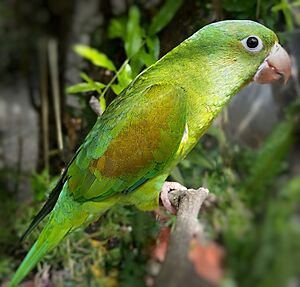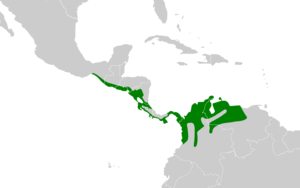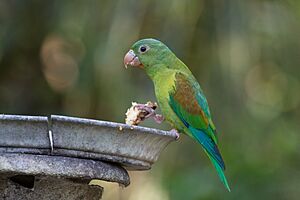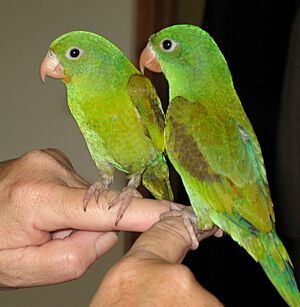Orange-chinned parakeet facts for kids
Quick facts for kids Orange-chinned parakeet |
|
|---|---|
 |
|
| Male specimen in Honduras | |
| Conservation status | |
| Scientific classification | |
| Genus: |
Brotogeris
|
| Species: |
jugularis
|
 |
|
The orange-chinned parakeet (Brotogeris jugularis) is a small, colorful bird. It is also called the Tovi parakeet. This bird is part of the parrot family, known as Psittacidae. You can find it living in warm areas from southern Mexico through Central America. Its home range extends into Colombia and Venezuela in South America.
Contents
What is the Orange-chinned Parakeet?
The orange-chinned parakeet has two main types, called subspecies. The first is B. j. jugularis, which was named by Müller in 1776. The second is B. j. exsul, named by Todd in 1917. These two types are very similar but have slight differences. Scientists have also suggested another type, B. j. apurensis, but it is not widely accepted. The orange-chinned parakeet is closely related to the grey-cheeked parakeet. They are like "sister species" in the bird world.
How to Identify an Orange-chinned Parakeet?
This parakeet is about 18 to 19 centimeters (7 to 7.5 inches) long. It weighs between 53 and 65 grams (about 2 ounces). Adult birds of the main type have a bright green head. Their crown, which is the top of their head, has a bluish tint. They have a white ring around their eyes. A small orange patch on their chin gives them their name. This orange patch can sometimes be hard to spot.
Their upper body and tail feathers are a bluish-green color. Their wing feathers, especially those covering the wings, are brown. These brown parts look like "shoulders" when the bird is sitting. The underside of their body is mostly bright green. Their lower belly and upper legs have a bluish shade. The feathers under their wings are yellow. Young parakeets look very much like the adults. The B. j. exsul subspecies has green underparts. Its orange chin patch is smaller and lighter. Its "shoulders" are darker, and its back feathers are more olive green.
Where Do Orange-chinned Parakeets Live?
The B. j. jugularis subspecies lives in a much larger area. It is found starting from the state of Oaxaca in southwestern Mexico. From there, it lives mostly along the Pacific coast of Central America. Its range continues through western, central, and northern Colombia. It also reaches into northwestern Venezuela.
The B. j. exsul subspecies lives in a smaller area. You can find it in northeastern Colombia's Arauca Department. It also lives in northern and western Venezuela, as far as Guárico.
These parakeets prefer open or partly open places. They live in grasslands called Llanos. They also like forests where trees lose their leaves, and younger forests that have grown back. You can find them in forests along rivers, called gallery forests. They also live in fruit farms and in towns where there are trees. They do not like dense, evergreen forests. They can live from sea level up to about 1,400 meters (4,600 feet) high.
Orange-chinned Parakeet Behavior
Movement and Social Life
Orange-chinned parakeets usually stay in one area. However, in places like El Salvador, they might move around locally after their breeding season. You will often see them in pairs. Sometimes, they gather in small groups or flocks.
What Do Orange-chinned Parakeets Eat?
These parakeets often look for food with other birds. They might forage alongside the larger orange-fronted parakeet. They eat many different kinds of food. Their main diet includes fruits and seeds. But they also eat flowers, herbs, and sweet nectar from plants. Sometimes, they eat insects and even algae. They might sometimes eat fruits grown by farmers. Like many parrots, they also eat mineral-rich soil. This helps them get important nutrients.
Reproduction and Life Cycle
The breeding season for the orange-chinned parakeet is from January to April. They usually make their nests in old holes made by woodpeckers. They might also use natural holes in trees. Sometimes, they dig their own holes in nests made by termites in trees. It has even been seen that several pairs might nest together in a large, rotten tree stump.
A female parakeet usually lays four to seven eggs. If they are kept in captivity, the eggs hatch in about 21 to 26 days. The young birds are ready to leave the nest about two to three weeks after they hatch.
Vocalization and Calls
The orange-chinned parakeet makes several distinct sounds. Their common calls are high-pitched sounds like "klee" or a sharp "chree." They also make a two-part sound, "chree-chree." These calls are used when they are sitting or flying. They also make a quick, chattering sound, like "cra-cra-cra-cra-cra." When they are active, they often make a constant, loud, and harsh chattering noise.
Conservation Status of the Orange-chinned Parakeet
The IUCN (International Union for Conservation of Nature) has evaluated the orange-chinned parakeet. They have listed it as a species of "Least Concern." This means that it is not currently considered to be in danger of disappearing. The bird lives across a very large area. Scientists estimate there are at least half a million mature individual birds. However, this number is thought to be slowly decreasing. No immediate major threats to the species have been found. It is considered common to very common in most of its range. But it is less common in Oaxaca, Mexico.




